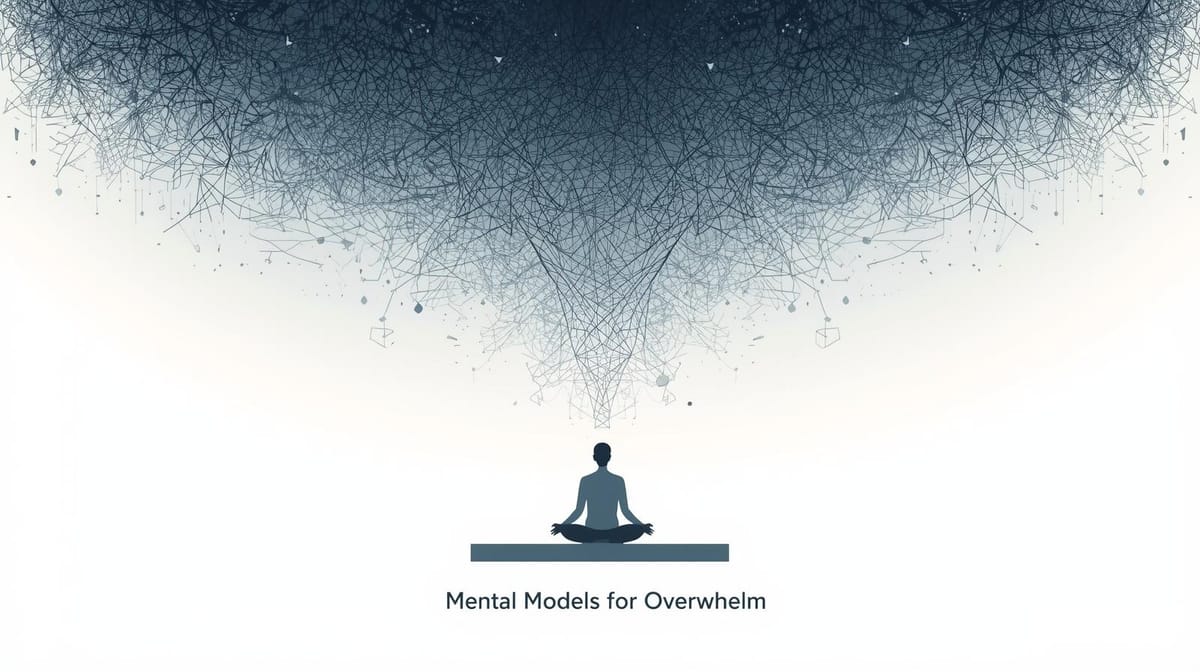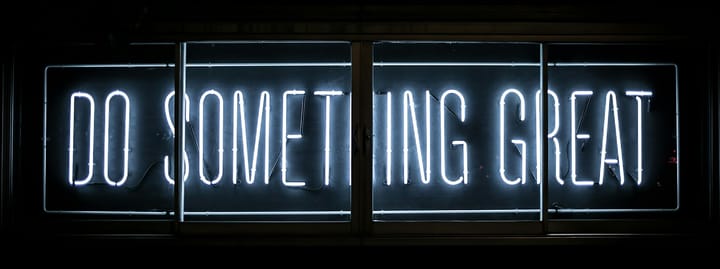Mental Models I Use When Everything Feels Overwhelming
Drowning in decisions and spinning your wheels? These mental frameworks help you think clearly when your brain wants to shut down.

Drowning in decisions while your brain spins like a broken washing machine?
I know that feeling. When everything seems urgent, every choice feels wrong, and your to-do list is breeding faster than you can kill it. Your mind jumps between problems without solving any of them, like a ping-pong ball in a tornado.
Most advice about overwhelm is either too vague ("just breathe and prioritize") or too complex (detailed productivity systems that take hours to set up). What you need in overwhelming moments are simple mental tools that cut through the noise.
Mental models are thinking frameworks that help you process information and make decisions more effectively. They're like having a calm, wise friend in your head who can see the situation clearly when you can't.
Battle-tested by someone who goes from "everything is on fire" to "okay, I can handle this" using these specific thinking tools.
Why Your Brain Gets Overwhelmed
Information overload: Too many inputs competing for attention
Decision fatigue: Every choice depletes your mental energy
Threat detection: Your brain interprets overwhelm as danger and shuts down higher thinking
Pattern matching failure: When situations feel new and complex, your brain can't quickly categorize them
Future focus anxiety: Thinking about everything that could go wrong instead of what you can control now
The solution: Simple frameworks that help you categorize, prioritize, and act even when your brain is fried.
🎯 Immediate Overwhelm Relief Models
The "Triage" Framework
Borrowed from: Emergency medicine
Use when: Everything feels urgent and important
The model: Categorize tasks like emergency room patients
Categories:
- Critical: Will cause real damage if not handled today
- Urgent: Important but can wait 24-48 hours
- Stable: Important but flexible timing
- Can wait: Won't matter if delayed by a week
Application: List everything overwhelming you, then sort into these categories. Start with critical, ignore "can wait" completely.
Reality check: Usually only 1-2 things are actually critical.
The "10-10-10 Rule"
Borrowed from: Decision science
Use when: Stuck between choices or paralyzed by consequences
The question: How will I feel about this decision in 10 minutes, 10 months, and 10 years?
Examples:
- Saying no to extra project: 10 minutes (guilty), 10 months (relieved), 10 years (doesn't matter)
- Taking a mental health day: 10 minutes (anxious), 10 months (grateful), 10 years (doesn't matter)
- Having difficult conversation: 10 minutes (uncomfortable), 10 months (glad I did it), 10 years (doesn't matter)
Insight: Most daily stresses matter way less over time than they feel right now.
The "Circle of Control" Model
Borrowed from: Stephen Covey
Use when: Feeling helpless and anxious about outcomes
The framework: Sort concerns into three circles
Inner circle (full control): Your actions, responses, effort, attitude
Middle circle (influence): Other people's decisions through your actions
Outer circle (no control): Weather, economy, other people's choices, past events
Application: Focus 90% of energy on inner circle, 10% on influence circle, 0% on outer circle.
Overwhelm reducer: Realizing how much you DON'T need to control is liberating.
🧠 Decision-Making Models for Clarity
The "Good Enough" Principle
Borrowed from: Behavioral economics (satisficing vs. maximizing)
Use when: Perfectionism is paralyzing you
The concept: Aim for decisions that meet your criteria, not perfect decisions
How to apply:
- Define "good enough" criteria before researching options
- Choose the first option that meets all criteria
- Stop researching once you've decided
- No second-guessing unless new major information emerges
Example: Choosing a restaurant that's clean, has food you like, and fits your budget vs. researching every restaurant in the city for the "perfect" meal.
The "Opportunity Cost" Frame
Borrowed from: Economics
Use when: FOMO is making every choice feel wrong
The question: What am I giving up to choose this option?
Application:
- Saying yes to this meeting = Giving up focused work time
- Scrolling social media = Giving up reading, exercise, or rest
- Working late tonight = Giving up time with family or sleep
Clarity boost: Makes trade-offs explicit instead of hidden.
The "Regret Minimization" Framework
Borrowed from: Jeff Bezos
Use when: Making big life decisions
The process: Project yourself to age 80 and ask which choice you'd regret NOT trying
Examples:
- Starting a business: Will regret not trying more than trying and failing
- Moving to new city: Will regret not experiencing it more than potential discomfort
- Having difficult conversation: Will regret not speaking up more than temporary awkwardness
Best for: Major life choices, not daily decisions.
🔧 Productivity Models for Action
The "Next Action" Method
Borrowed from: David Allen (Getting Things Done)
Use when: Big projects feel overwhelming and unclear
The question: What's the very next physical action required to move this forward?
Examples:
- "Plan vacation" → Next action: "Google flights to Portland"
- "Get healthy" → Next action: "Put workout clothes by bed"
- "Improve finances" → Next action: "Log into bank account"
Why it works: Concrete actions are less overwhelming than abstract goals.
The "Energy-Task Matching" Model
Borrowed from: Ultradian rhythm research
Use when: Everything takes longer than expected
The framework: Match task difficulty to your current energy level
High energy tasks: Creative work, difficult conversations, complex problem-solving
Medium energy tasks: Planning, organizing, routine work
Low energy tasks: Email, data entry, simple administrative work
Application: Stop forcing high-energy tasks when you're mentally depleted.
The "Batching" Principle
Borrowed from: Manufacturing efficiency
Use when: Constant context switching is exhausting
The method: Group similar tasks and do them all at once
Examples:
- Communication batch: All emails, texts, and calls in one session
- Decision batch: Plan meals for the week instead of deciding daily
- Admin batch: Pay bills, update calendar, file documents together
Mental benefit: Reduces the cognitive load of constantly switching between different types of thinking.
🎪 Stress Response Models
The "Zoom Out" Technique
Borrowed from: Stoic philosophy
Use when: Current problems feel enormous
The exercise: Imagine viewing your situation from increasing distances
Levels:
- From across the room: How big does this problem look?
- From space: Can you even see this problem from orbit?
- From history: Will this matter in 100 years?
- From death bed: What will you remember about this time?
Perspective shift: Most daily stresses shrink dramatically with distance.
The "Both/And" Framework
Borrowed from: Dialectical thinking
Use when: Stuck in black-and-white thinking
The approach: Hold two seemingly contradictory truths simultaneously
Examples:
- I'm overwhelmed AND I'm capable of handling this
- This situation sucks AND I can learn from it
- I'm behind on goals AND I'm making progress
- I feel scared AND I can take action anyway
Overwhelm relief: Reduces pressure to have everything figured out perfectly.
📊 Planning Models for Sanity
The "Single Priority" Rule
Borrowed from: Warren Buffett
Use when: Everything feels equally important
The method: Choose ONE priority for the day/week/month and defend it
Process:
- List everything that feels important
- Pick the single most important item
- Treat everything else as "not today" items
- Protect the priority from other demands
Paradox: Doing less often accomplishes more than trying to do everything.
The "Time Boxing" Model
Borrowed from: Agile development
Use when: Tasks expand to fill available time
The framework: Assign fixed time blocks to activities
Examples:
- Email: 30 minutes maximum, twice daily
- Planning: 15 minutes each morning
- Socializing: 1 hour lunch break, not all day
- Research: 45 minutes maximum before making decision
Benefit: Creates artificial urgency that improves focus and prevents perfectionism.
🚫 When Mental Models Don't Help
During acute mental health crises: Professional help is needed
When overwhelmed by grief or trauma: Processing emotions comes before productivity
During physical illness: Rest and recovery take priority
When basic needs aren't met: Address food, sleep, and safety first
Remember: Mental models are tools for normal overwhelm, not substitutes for professional support when needed.
🔄 Building Your Mental Model Toolkit
Start with Three Models
Choose one from each category:
- Overwhelm relief: Triage, 10-10-10, or Circle of Control
- Decision making: Good Enough, Opportunity Cost, or Next Action
- Stress response: Zoom Out, Both/And, or Single Priority
Practice During Calm Moments
Don't wait for overwhelm to try these tools
- Practice triage on a regular to-do list
- Use 10-10-10 for small decisions
- Apply zoom out to minor annoyances
Create Quick Reference
Write down your favorite frameworks in simple language you can access when stressed
Example card:
- Overwhelmed? → Triage (Critical/Urgent/Stable/Wait)
- Can't decide? → How will I feel in 10 minutes/months/years?
- Stressed? → What can I control right now?
The Meta-Model: Choosing Which Model to Use
For immediate relief: Triage or Circle of Control
For decisions: 10-10-10 or Good Enough
For planning: Single Priority or Time Boxing
For perspective: Zoom Out or Both/And
For action: Next Action or Energy-Task Matching
The key: Having a small toolkit you know well beats having many models you forget under pressure.
Feeling overwhelmed right now? Try the Triage framework on whatever's stressing you most, then get in touch with how it goes - I love hearing which mental models resonate with different people.
Want more stress management tools? Check out our small behaviors that compound into relief or explore problem-solving tools for getting hard tasks done.


